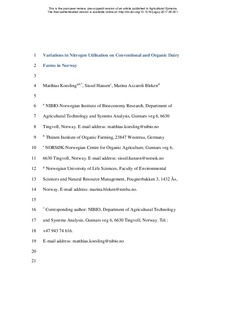| dc.description.abstract | Reduced N-surpluses in dairy farming is a strategy to reduce the environmental pollution from this production. This study was designed to analyse the important variables influencing nitrogen (N) surplus per hectare and per unit of N in produce for dairy farms and dairy systems across 10 certified organic and 10 conventional commercial dairy farms in Møre og Romsdal County, Norway, between 2010 and 2012. The N-surplus per hectare was calculated as N-input (net N-purchase and inputs from biological N-fixation, atmospheric deposition and free rangeland) minus N in produce (sold milk and meat gain), and the N-surplus per unit of N-produce as net Ninput divided by N in produce. On average, the organic farms produced milk and meat with lower N-surplus per hectare (88 ± 25 kg N·ha−1) than did conventional farms (220 ± 56 kg N·ha−1). Also, the N-surplus per unit of N-produce was on average lower on organic than on conventional farms, 4.2 ± 1.2 kg N·kg N−1 and 6.3 ± 0.9 kg N·kg N−1, respectively. All farms included both fully-cultivated land and native grassland. Nsurplus was found to be higher on the fully cultivated land than on native grassland. N-fertilizers (43%) and concentrates (30%) accounted for most of the N input on conventional farms. On organic farms, biological Nfixation and concentrates contributed to 32% and 36% of the N-input (43 ± 18 N·kg N−1 and 48 ± 11 N·kg N−1), respectively. An increase in N-input per hectare increased the amount of N-produce in milk and meat per hectare, but, on average for all farms, only 11% of the N-input was utilised as N-output; however, the N-surplus per unit of N in produce (delivered milk and meat gain) was not correlated to total N-input. This surplus was calculated for the dairy system, which also included the N-surplus on the off-farm area. Only 16% and 18% of this surplus on conventional and organic farms, respectively, was attributed to surplus derived from off-farm production of purchased feed and animals. Since the dairy farm area of conventional and organic farms comprised 52% and 60% of the dairy system area, respectively, it is crucial to relate production not only to dairy farm area but also to the dairy system area. On conventional dairy farms, the N-surplus per unit of N in produce decreased with increasing milk yield per cow. Organic farms tended to have lower N-surpluses than conventional farms with no correlation between the milk yield and the N-surplus. For both dairy farm and dairy system area, N-surpluses increased with increasing use of fertilizer N per hectare, biological N-fixation, imported concentrates and roughages and decreased with higher production per area. This highlights the importance of good agronomy that well utilize available nitrogen. | nb_NO |

